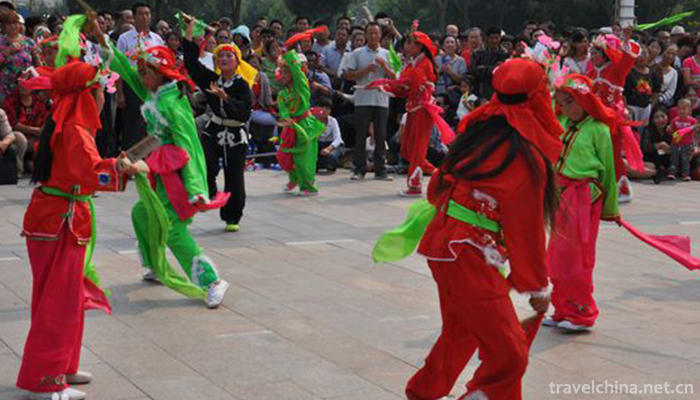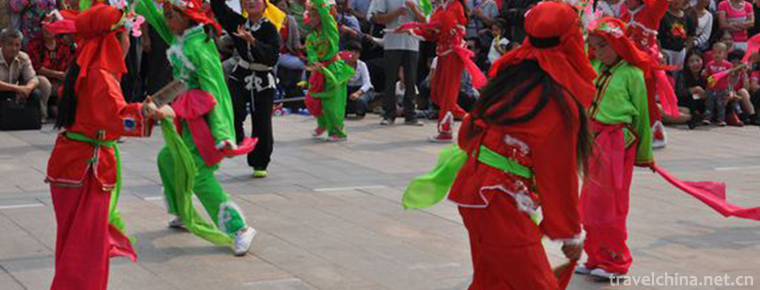Cangzhou Lazi
Cangzhou Lazi
Cangzhou Laozi is a traditional folk dance with strong local characteristics in the central area of Hebei Province. Laozi is one of the representative folk dances in Hebei Province. It spreads in Cangzhou, especially in Cangxian and Nanpi counties. It has a history of more than 150 years. In winter, when the farmers are free, they rehearse and perform around the fifteenth day of the first lunar month to show the joy of celebrating the harvest and leaving the old to welcome the new.
In June 2008, Cangzhou Luozi declared by Nanpi County of Hebei Province was listed in the second batch of national intangible cultural heritage list with the approval of the State Council.
Heritage serial number: 643 III-46.
historical origin
According to Cangxian County Chronicle of Hebei Province, Laozi is a small farm in the big Yangko, which originated in Jiaqing and Daoguang years of the Qing Dynasty (1796-1821). Traditionally, women walk on Cun stilts (also known as Cun stilts), hold flower fans or bamboo boards, and men beat bully whips with their hands. Laozi's dance is characterized by fewer fans and flowers, more dancing postures and shapes, paying attention to the beauty of curves and paying attention to charm. The style of fan dancing is natural and unrestrained. The action range of board dancing is large, the rhythm changes a lot, and it is very bright.
artistic characteristics
Form of performance
Wen Laozi mainly composed of songs and dances, often performing several folk songs together. In the equipments of props, whips, boards and fans are interlaced with each other, and only fans are used for performances. The local people call it Wen Laozi or Xiao Fengyuan. After the Revolution of 1911, women's foot binding began to be liberated, and men dressed as women began to be eliminated. As a result, the movements of Laozi dance have been enriched and developed accordingly. On the basis of Wen Laozi, some movements and techniques in opera have been properly absorbed, which blend with the movements of Laozi dance, adding a warm, robust, cheerful and bold atmosphere, strengthening the elements of dance and martial arts, and reducing the composition of songs accordingly. On props, only whip and board are used, no fan is used. Locals call it Wu Luozi or Feng Yangge.
Art schools
The first group was Yang Fa-tzu, who performed only four whips at the earliest stage, and then changed to four whips and four boards. Later, the performances of fans were added, which were divided into five whips, three boards and two fans. In the process of handing down from generation to generation, each generation of artists has made different degrees of improvement and development of Yang Fa Laozi, making it increasingly perfect, leaving valuable folk art heritage for future generations.
The other is the cap school. At first there was only a martial field accompaniment, then a literary field accompaniment was added. The Hat Family did not perform with fans, but only with two whips and eight boards. Cangzhou people are fond of practicing martial arts and have been influenced by martial arts for a long time. Therefore, it is also evidently reflected in the dance of falling sons. The basic movements of male performers in Fall Zi Dance mainly come from the single-knife style in Wushu. For example, it is the most basic action of male actors. "Xubu" is a triangular route, which is called "triangular riveting" by the old artists. That is to say, the pace is steady, just like riveting on the ground. The actresses'movements such as "drawing board", "winding head board", "pedaling" and "empty step" are also close to those of Wushu.
Traditional programs
The traditional programs of Laozi mostly express the hard life of the working people in the old society, as well as love stories and people's longing for freedom, happiness and a better life, such as Jasmine Flower, Kite Flying, Sighing Lover, Embroidered Handkerchief, Nigu Sifan, etc. Among them, "Rongli Flower" and "Kite Flying" are processed and sorted out to be more beautiful and moving, and become the lasting reserved programs in the dance arena.
Inheritance status
Zhou Shutang, the late famous folk dancer, made outstanding contributions in inheriting and developing Cangzhou Laozi. Zhou Shutang studied art in "Laozi Fang" since childhood. After more than forty years of training, he has become an art genre of Laozi Dance. His dancing rhythm is characterized by a prominent depiction of the female "three bends" dance posture: the head is crooked, the waist is twisted, the legs are curved, the lines are beautiful, the charm is strong, making people feel elegant, beautiful and dignified. In terms of dance steps, it absorbs the advantages of Chinese classical dance and brotherly national dance. Zhou Shutang believes that if folk dance does not develop and innovate, there will be no vitality. In order to develop the slab dance and fan dance in Laozi dance, he recorded many dance vocabulary and dance movement rhythm from folk dances of various nationalities. After some analysis and research, he melted many dance language into the dance, and then processed more than 20 sets of fan flower and slab dance action combinations. These magnificent and varied movements have enhanced the expressive force of Laozi dance and developed the traditional art of Laozi dance.


-
1.Daishan Lake
Daishan Lake is located in the ancient town of Feidong County, Hefei City, Anhui Province. Daishan Lake has a subtropical climate, warm and humid, with an average annual temperature of 15.7 degrees Ce
Time 2019-01-08 -
2.maoming forest park
Maoming Forest Park is located in the western suburb of Maoming City, Guangdong Province. It is only 12 kilometers away from the urban area and covers an area of more than 4500 mu
Time 2019-02-07 -
3.Taoyuan Xiangu Natural Scenic Area
Beijing Taoyuan Xiangu Scenic Spot is a national AAAA-level scenic spot. It is 90 kilometers away from Beijing. It starts from the West Bank of Miyun Reservoir in the East and reaches the top of Guanf
Time 2019-02-13 -
4.Eight treasures Orange Cup
Babao Orange Cup is a delicacy. Its main ingredients are mushrooms, horseshoe, ham and chicken breast.
Time 2019-03-25 -
5.Lantern Dance
Lantern dance is a Chinese folk dance with a long history. It has been performed mainly on Lantern Festival for at least 1,000 years. Lantern dance originated from Lantern Festival and its production
Time 2019-04-26 -
6.Yueqing Poplar Wood Carving
Yueqing boxwood carving, a kind of ornamental round carving art with boxwood as its material, is mainly popular in Houhengcun, Wengyuan Street and Lecheng Street of Liushi Town in Yueqing City,
Time 2019-05-11 -
7.Music of Confucius Festival in Liuyang Temple
The ancient music of offering sacrifices to Confucius in Liuyang Temple is a traditional folk music in Hunan Province. A list of the second batch of intangible cultural heritage in Hunan Province has
Time 2019-05-14 -
8.Qinghai Yuexian
Qinghai Yuexian is also called Yuexian, Yueyue Diao, Back Diao, Yueyue Diao, Meihu, etc. Qinghai Vietnamese String is one of the traditional folk songs in Qinghai Province. It can be called the "
Time 2019-06-11 -
9.Xie Rong Zhongzi
Xierong Zhongzi still keeps the primitive and simple legacy, from which we can see the spiritual sustenance and aesthetic pursuit of Tibetan ancestors. This kind of primitive culture and art has becom
Time 2019-07-06 -
10.Deng Xiaoping
Deng Xiaoping (August 22, 1904 -1997 February 19th), formerly known as Deng Xiansheng, the scientific name of Deng Xixian, Guang'an, Sichuan. Go to Europe early Work study program After his return, he
Time 2019-09-07 -
11.Deyang local culture
On April 2, 2013, the Information Office of the people's Government of Deyang City, Sichuan Province announced the city logo of Deyang to the public. Among them, "the source of ancient Shu, the city of heavy loading" has become the main logo of Deyang City
Time 2020-12-14 -
12.Population and nationality of Suining
At the end of 2019, the total number of household registration in Suining was 1 million 380 thousand, and the household registration population was 3 million 629 thousand, a decrease of 0.7% over the previous year, of which 1 million 4 thousand and 900
Time 2020-12-16